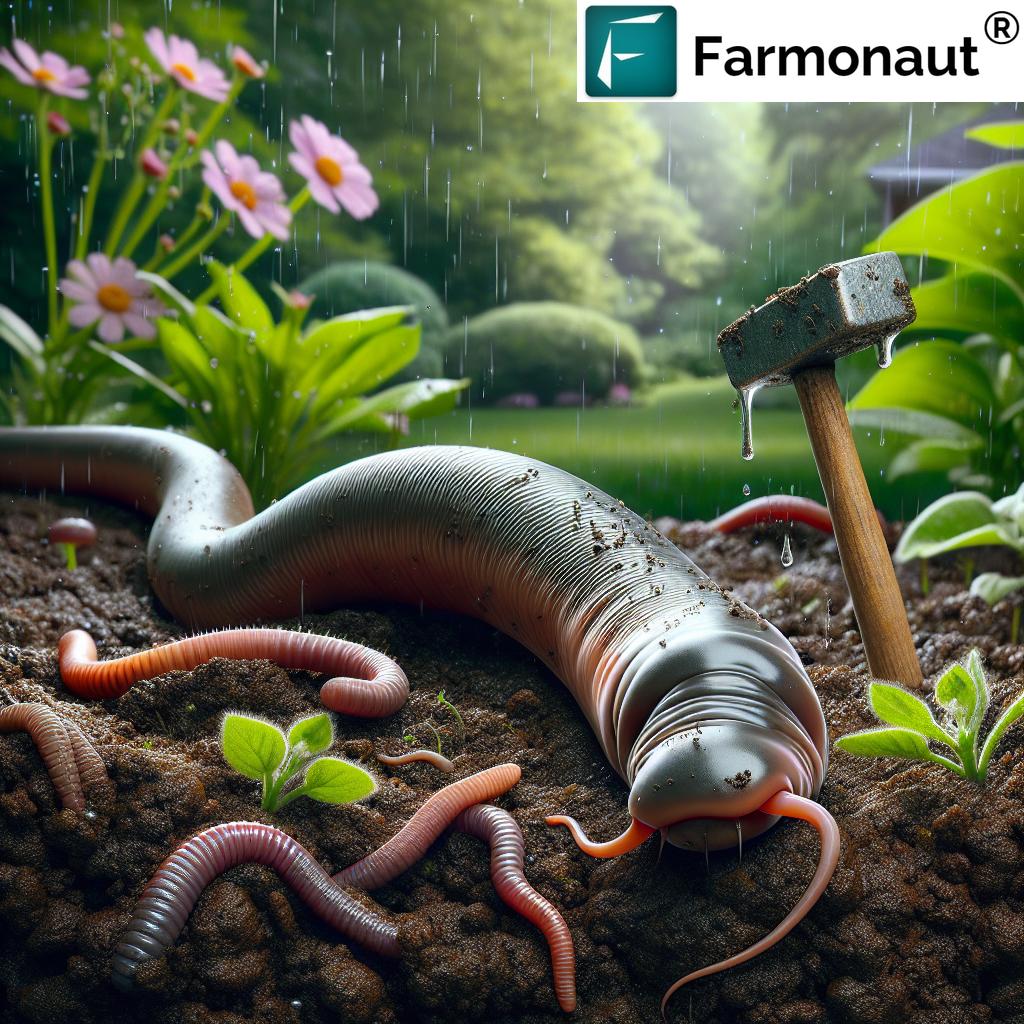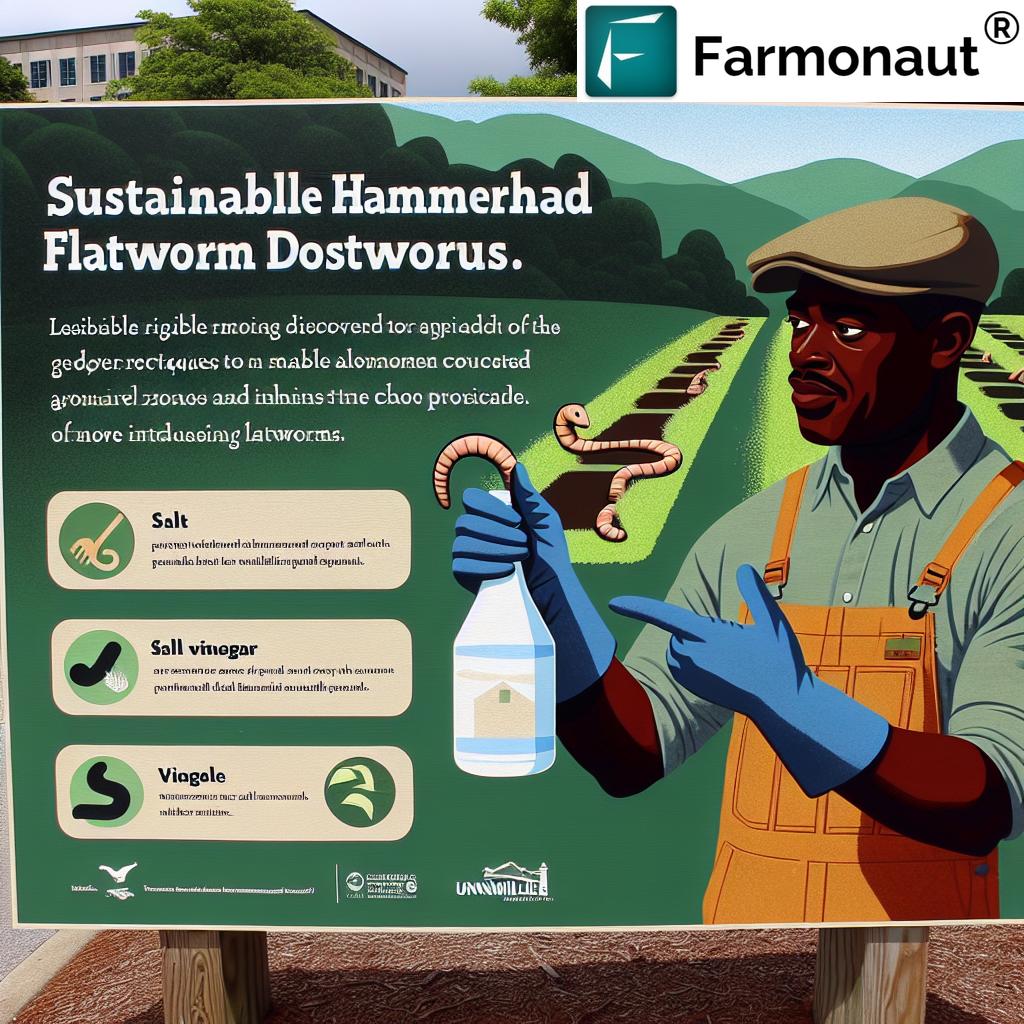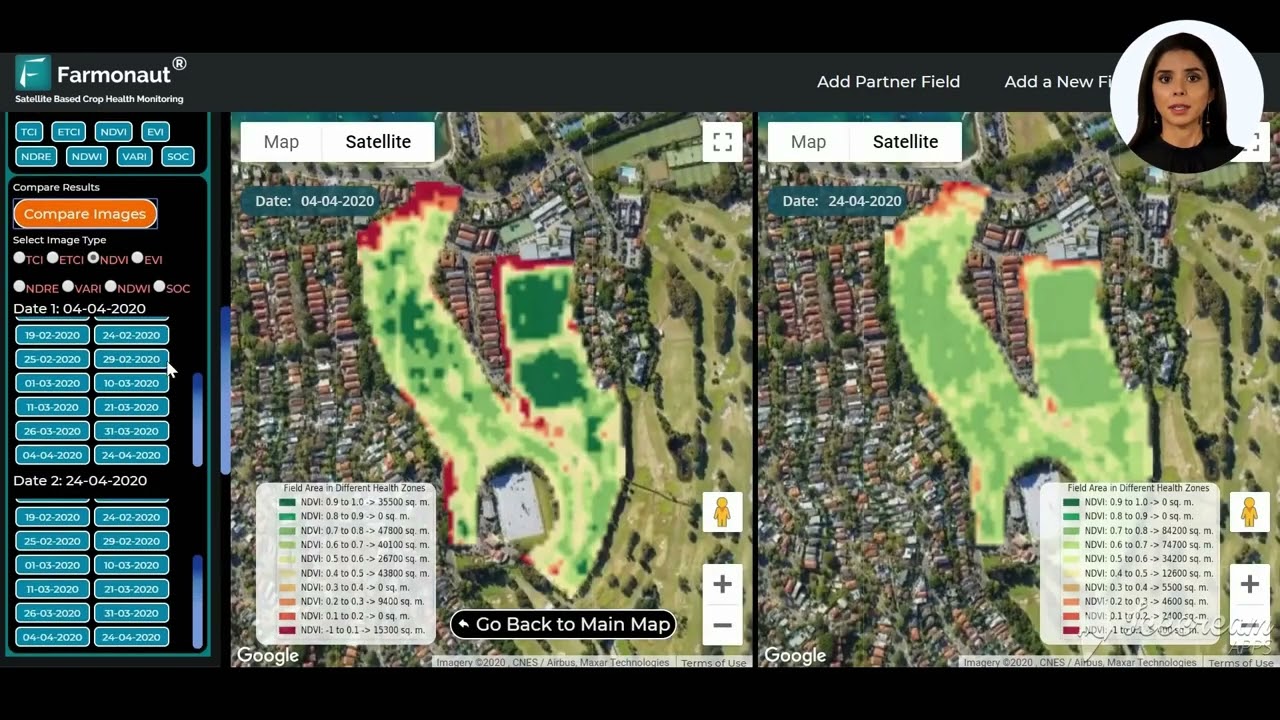Table of Contents
- Introduction
- What Are Invasive Hammerhead Flatworms?
- The Threat of Hammerhead Flatworms in Tennessee
- Impact of Flatworms on Tennessee’s Environment
- Identifying Invasive Hammerhead Flatworms
- 7 Expert Eco Tips: How to Get Rid of Flatworms in Soil and Gardens
- Comparative Table: Impacts and Disposal Methods
- Spread of Invasive Flatworms in Nursery Plants
- Preventing Spread: Protecting Garden Soil from Invasive Species
- Sustainable Gardening: Precision Solutions with Farmonaut
- FAQ – Hammerhead Flatworms in Tennessee
- Conclusion
Invasive Hammerhead Flatworms in Tennessee: 7 Expert Eco Tips
As temperatures and humidity rise across Knoxville and throughout the Tennessee Valley, a silent invader threatens our region’s gardens and ecosystems—the invasive hammerhead flatworm. Gardeners, farmers, and homeowners alike are noticing these strange, snake-like creatures turning up in their landscape beds, mulch, and even on patio walkways. But what challenges do these invasive species really pose to our soils, earthworms, plants, and trees? What are the safe, sustainable solutions for removing flatworms from garden plants? And how do we prevent their spread, especially via nursery plants and landscaping soil?
In this comprehensive guide, we combine the latest recommendations from the Tennessee Valley Authority (TVA), the Texas Invasive Species Institute, and our own eco-knowledge to tackle invasive hammerhead flatworms head-on. Learn 7 expert eco tips to manage, remove, and prevent these carnivorous pests, while promoting sustainability in your gardening practices.
What Are Invasive Hammerhead Flatworms?
Invasive hammerhead flatworms (Bipalium spp.) are predatory, carnivorous worms originally native to Southeast Asia. Their distinctive half-moon or “hammerhead” shaped head and elongated, serpentine bodies (up to 15 inches long!) make them easy to recognize—if quite unsettling. Typically, their coloring is a light honey hue, with dark longitudinal stripes or spots along their length.
These flatworms are not a new arrival in the U.S., but their prominence is growing due to increasing temperatures, humid environments, and the spread of nursery plants containing contaminated soil. First believed to have entered North America through soil imported with landscape plants in the early 1900s, they have become persistent across Tennessee, causing significant concern among gardeners and ecologists.
- Origin: Native to Southeast Asia
- Introduction in the U.S.: Early 20th century via infested nursery soil
- Common Habitat: Damp garden beds, landscaping soil, under rocks, mulch, and potted plants
- Diet: Carnivorous—primarily feed on native earthworms and beneficial soil invertebrates
The Threat of Hammerhead Flatworms in Tennessee
The impact of flatworms on earthworms is perhaps the most significant ecological concern. Earthworms are the unsung heroes of our area’s soils—they aerate, decompose, and turn organic material into nutrient-rich humus vital for plant, crop, and tree survival. But hammerhead flatworms are voracious predators, carnivorous in their feeding habits, often consuming dozens of earthworms each month.
According to the TVA (Tennessee Valley Authority), these worms can significantly disrupt the ecosystem:
- Soil health declines as earthworm populations dwindle
- Plants and crops struggle to access essential nutrients due to reduced soil aeration and decomposition
- Native species and delicate balances are thrown off, risking wider negative effects in the Tennessee environment
Unfortunately, many residents in Knoxville and the broader Tennessee Valley have already started seeing an uptick in sightings—especially during the humid summer weather when these flatworms are most active outdoors.
Impact of Flatworms on Tennessee’s Environment
The invasive hammerhead flatworms represent a substantial threat to Tennessee‘s agricultural sustainability. Their arrival poses multiple challenges:
- Disrupted Nutrient Cycles: By decimating native earthworm populations (with observed decreases of 30–60% in some regions), these pests interfere with the natural decomposition of organic matter and the release of plant nutrients.
- Compost & Mulch Contamination: Hammerhead flatworms often hide in moist, decaying organic material, which can lead to contaminated compost or mulch beds.
- Impacts on Crops & Trees: The knock-on effect is that garden plants, crops, and even mature trees may struggle to extract necessary nutrients from the soil, leading to poor growth or even death in severe cases.
- Native Species Displacement: Because hammerhead flatworms are not native, they outcompete and prey upon beneficial invertebrates, reducing the region’s ecological resilience.
Identifying Invasive Hammerhead Flatworms
Proper identification is key to removing flatworms from garden plants safely and effectively. Be on the lookout for these features:
- Distinct Hammerhead Shape: The head is expanded and flattened, forming a crescent that looks much like a tiny hammer.
- Elongated, Flexible Body: Can stretch from 8 up to 15 inches, and remarkably thin—snake-like in movement.
- Coloration: Most are pale honey, although some may appear slightly greenish or silver with one or more longitudinal stripes or spots (usually 1–5).
- Mucous Secretion: They leave behind a sticky, toxic mucus trail that can cause irritation if touched with bare skin.
- Responsive to Moisture: You’ll often discover them in wet, humid areas—under rocks, around potted nursery soil, or after heavy summer rain.
Important Note: Do not confuse hammerhead flatworms with our beneficial native earthworms, which are vital for soil health and do not have a hammer-shaped head!
7 Expert Eco Tips: How to Get Rid of Flatworms in Soil and Gardens
Let’s break down practical, science-backed steps every Tennessee gardener can use to manage and remove these pests—in ways that are both safe for you and sustainable for our broader ecosystem. Never cut these flatworms; each piece can regenerate into an entirely new worm (a major issue for proper disposal).
1. Manual Removal with Gloves
- Always use gloves or tongs when collecting hammerhead flatworms to avoid toxic skin contact and parasite exposure.
- Place flatworms directly into a sealed plastic bag for containment.
2. Salt-Based Hammerhead Flatworm Disposal Methods
- Cover the flatworm completely in salt within a sealed bag. Salt disrupts the worm’s water balance, killing it effectively.
- Let the sealed bag sit for several hours before placing it in the trash.
- This prevents the flatworm from crawling away or regenerating.
3. Rubbing Alcohol or Vinegar Drench
- Direct application of rubbing alcohol or vinegar (household strength) onto the flatworm will kill it. This is effective if you catch a worm on a hard surface.
- Transfer to a sealed bag afterward to prevent escape and dispose of safely.
- For an organic touch, spray a mixture of citrus oil and vinegar for added lethality (as recommended by the Texas Invasive Species Institute).
4. Freezing for Safe and Ethical Disposal
- If you’re uncomfortable using chemicals, bag the flatworm securely and place in the freezer for at least 24 hours.
- Afterwards, discard the contents with regular waste—ensuring the worm cannot escape or regenerate.
5. Never Chop or Crush
- Resist the urge to chop these invasive creatures—each fragment left behind can regenerate into a fully functioning new flatworm!
- This unique trait makes proper disposal absolutely crucial.
6. Quarantine New Nursery Plants
- Always inspect soil around new plants purchased from nurseries or landscaping suppliers.
- Keep newcomers isolated for several days in a controlled environment—look for signs of flatworms before integrating into your main garden.
- This simple protocol drastically reduces risk of introducing these invasive flatworms to your property.
7. Monitor Hot, Humid Areas—Especially During Summer Weather
- Hammerhead flatworms prefer humid environments; check mulch beds, compost heaps, and shaded garden corners regularly when Tennessee summers heat up.
- Keep landscaping areas well-drained where possible and clear away excess debris that could provide shelter.
By adopting these gardening tips for invasive flatworm control, we not only protect our gardens but also contribute to a larger statewide effort for sustainable, eco-conscious gardening.
Comparative Table: Impacts and Disposal Methods
| Threatened Element | Estimated Impact Level | Potential Consequences | Recommended Disposal/Eco Tip |
|---|---|---|---|
| Soil | High | Disrupted nutrient cycling; reduced organic matter breakdown | Manual removal with gloves; keep soil moist, but drain excess water |
| Earthworms | High (30–60% estimated reduction in populations) | Decline of native earthworms; lower soil aeration and fertility | Safe salt or vinegar disposal in sealed bag |
| Plants & Crops | Moderate–High | Root damage risk; stunted growth from nutrient deficits | Monitor plants, remove flatworms, keep plant bases clear |
| Trees | Moderate | Slower growth; yellowing leaves due to less soil nutrients | Regularly check mulch and roots for flatworms |
| Gardeners | Low (personal health risk) | Potential skin irritation or exposure to parasites if touched | Use gloves/tongs; never touch flatworms bare-handed |
| Nursery & Landscaping Materials | Moderate | Unintentional spread of invasive species in new environments | Inspect, isolate, and treat new plants or nursery stock |
Spread of Invasive Flatworms in Nursery Plants
One of the most significant factors facilitating the spread of invasive flatworms in nursery plants is the movement of potting and landscaping soil. These worms and their eggs often remain hidden in moist soil, going unnoticed until they are introduced to a newly landscaped area or home garden.
- Nursery soil, especially if shipped across state lines, can harbor flatworm eggs or juveniles.
- Once in a new, moist garden environment, the worms can rapidly establish themselves and begin feeding on local earthworm populations.
Gardeners and landscapers should prioritize sourcing soil from reputable, local suppliers, and quarantine new plants before planting them in their main garden beds. Whenever possible, choose soil and mulch that has been solarized or heat-treated, as these processes help destroy pests and eggs.
Preventing Spread: Protecting Garden Soil from Invasive Species
Prevention, as with many invasive species in gardens, is more effective and less labor-intensive than dealing with a full-blown infestation. Here are steps all Tennessee gardeners can take to limit the risk:
- Inspect all new nursery and landscaping plants for hidden flatworms, particularly in soil clumps and around root balls.
- Educate your local gardening community: Share information through neighborhood groups or on social media about correct disposal of flatworms. One slip—such as cutting or composting—can worsen the problem.
- Practice strict garden hygiene by keeping compost piles and mulch moist—but never soggy—and turn regularly to discourage flatworm habitat.
- Avoid moving soil and mulch between different regions or yards unless it’s been thoroughly inspected and/or heat-treated.
- Regularly monitor your garden, especially after rain, and keep a record of sightings. Reporting new infestations helps agencies track and manage the spread.
For those managing large gardens, cooperatives, or community plots, advanced solutions such as Farmonaut’s Large-Scale Farm Management App can help monitor soil health, resource allocation, and pest outbreaks—including invasive hammerhead flatworms—using real-time satellite data and precision agriculture advisory.
Concerned about your soil’s environmental impact? Learn more about Farmonaut’s Carbon Footprinting Tool, which lets gardeners and farmers track and reduce the carbon footprint of their practices, in line with sustainability goals.
If you’re interested in traceability from field to table, check out Farmonaut’s product traceability solutions—empowering both commercial growers and consumers with verified, blockchain-backed records of agricultural products.
Developers and researchers:
Integrate real-time soil and weather data into your analysis or product design with the Farmonaut API and explore technical integration via the API developer documentation.
Sustainable Gardening: Precision Solutions with Farmonaut
While hands-on vigilance against invasive hammerhead flatworms is vital, we can now leverage modern technology for even more effective garden and field management. Farmonaut stands at the forefront of precision agriculture to help Tennesseans adapt, monitor, and thrive through the changing climate and emerging pest threats.
- Satellite-Based Crop and Soil Health Monitoring: Farmonaut’s platform uses multispectral imagery to identify changes in vegetation, detect stress early (such as from pest outbreaks), and ensure optimal soil health.
- Jeevn AI-Powered Advisory: Offers personalized, real-time advice—ideal for ideas ranging from removing flatworms from garden plants to optimizing irrigation and invertebrate population management.
- Resource & Fleet Management: For larger operations, leverage fleet and resource management to minimize inefficiencies while promoting eco-friendly logistics across your property or multiple sites.
- Blockchain Traceability: For those needing full supply chain verification, Farmonaut’s blockchain solution ensures transparent tracking—an increasingly important benefit for sustainable, responsible agriculture.
- Affordable, Scalable Access: Whether you operate a home plot in Knoxville or large acreage in the Valley, Farmonaut’s subscription-based model (see signup below) makes precision insights easy and accessible.
FAQ – Hammerhead Flatworms in Tennessee
What are hammerhead flatworms and why are they invasive in Tennessee?
Hammerhead flatworms are predatory, snake-like worms with a characteristic crescent-shaped head. Native to Southeast Asia, they are invasive in Tennessee because they prey upon and devastate native earthworm populations. As a result, they disrupt our soil’s ecosystem and can undermine plant health in gardens and farms.
How do I safely get rid of flatworms in my garden?
The best hammerhead flatworm disposal methods include wearing gloves to handle the worms, placing them in a sealed bag, and killing them with salt, rubbing alcohol, vinegar, or by freezing. Never chop them, as hammerhead flatworms can regenerate from body fragments!
Do hammerhead flatworms harm humans or pets?
These worms secrete a toxic mucous that can cause mild skin irritation if touched directly. Always use gloves when disposing of them. While they pose little direct threat to pets, ingestion should be avoided.
Can hammerhead flatworms spread through nursery plants?
Yes. These flatworms, and sometimes their eggs, are easily transported in soil with nursery plants. Always quarantine new plant arrivals and thoroughly inspect the soil to prevent introducing them to your main garden.
What’s the role of vinegar in hammerhead flatworm control?
Vinegar, especially when sprayed directly or combined with citrus oil, is toxic to hammerhead flatworms and can be used as a target-specific, eco-friendly way to kill them prior to disposal.
Where can I find tools for advanced soil and crop monitoring in Tennessee?
Explore Farmonaut’s precision agriculture platform for real-time satellite-based monitoring, pest and soil health insights—all tailored for Tennessee’s climate and agricultural needs.
Does cold weather affect invasive hammerhead flatworms?
These creatures are most active during warm, humid weather—common in Tennessee summers. However, they survive mild freezes by burrowing deeply into soil or mulch, emerging again when temperatures rise.
Conclusion: Building Sustainable Tennessee Gardens Against Hammerhead Flatworms
The battle against invasive hammerhead flatworms in Tennessee is a vital component of preserving our region’s soil health, biodiversity, and agricultural productivity. By following the eco expert tips above, we can minimize spread, protect our valuable earthworm populations, and ensure our gardens and crops remain nutrient-rich and sustainable for years to come.
As with all emerging pest threats, staying informed, collaborating with community members, and adopting new technologies ensures we’re not simply reacting, but actively building a resilient environment. Farmonaut’s precision solutions support everyday gardeners, landscape professionals, and large-scale growers as we work together toward a future where every Tennessee garden flourishes—free of destructive invasives.
Ready to take your eco gardening to the next level? Download the Farmonaut App for actionable, real-time insights, or explore our carbon footprinting and traceability solutions for comprehensive, sustainable farm management.
Let’s reclaim our soils, gardens, and environment—one flatworm at a time.






















